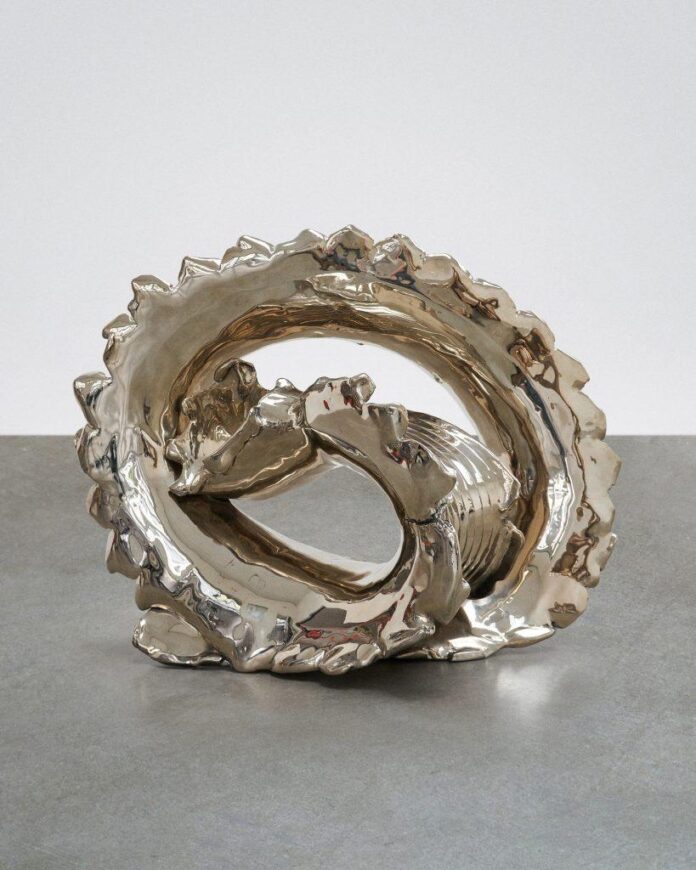One of the most anticipated shows of Paris Fashion Week, Loewe debuted its SS24 womenswear collection last Friday in a white tent constructed at the Château de Vincennes. Styled in an homage to retro masculinity, models with sideburns and neat quiffs took to the runway wearing chunky knit capes, trousers so high waisted they almost reached the chest, leather blazers, and V-neck sweaters over plaid shirts. With few breaks from a muted palette of camel, brown, gray, and black, most of the looks were surprisingly… wearable?

Three looks from the Loewe SS24 womenswear fashion show in Paris on September 29, 2023. Courtesy of Loewe.
When Loewe’s creative director Jonathan Anderson took over the brand a decade ago, he helped usher in a new era of viral runway moments. In a world now saturated with spray-on dresses and other gimmicks, Anderson delivered elevated normcore with subversive flourishes. Take a long leather coat that folds up at one side to become a handbag slung over the shoulder, offering quick flash of posterior, or an oversized sewing needle pierced across the front of a pair of shorts to keep its pleats in place. It was a defiant statement of cozy, quiet rebellion compared to the other catwalk offerings.

Sculptures by Lynda Benglis served as gleaming runway scenography. Courtesy of Loewe.
What stood out in the temporary tent’s otherwise pared down, dove gray interior were several gleaming gold sculptures by the 81-year-old radical post-modernist artist Lynda Benglis. Dazzling and dynamic, these large-scale, in-the-round bronze pieces set the tone for a collection that favored understatement with eye-catching quirks. Their highly polished surfaces supplied an otherworldy contrast to the muted outfits, and despite their monumentality, the wrought, jagged silhouettes produced dramatic gestures through space, paradoxically implying movement. Benglis’s sculptural scenography was adapted into the accessories that served as the glam, abstract pops for the collection, recreated and rendered in miniature as rings, bracelets and earrings that adorned the runway looks.

American sculptor Lynda Benglis, 1979. Photo by Nancy R. Schiff/Getty Images.
Though art-fashion crossovers are now the choice of a subversive conceptual artist like Benglis surely reflects Anderson’s cultivated tastes. Still working out of her Sante Fe studio, the legendary American artist rose to prominence in the 1960s for challenging post-minimal constructions that warped our understanding of sculpture and made imaginative use of emerging materials. Despite these conceptual, process-based experiments, she is perhaps best known for satirizing the art world boys club by posing naked straddling a vast phallus for a highly controversial ad placed in in 1974.

A model wears a Benglis earring. Photo: Molly Lowe, courtesy of Loewe.
Many years later, she has conversely brought a more traditionally feminine touch to Loewe’s notably androgynous looks. In some cases, Anderson allowed her jewellery to take center stage, as when a bejewelled ear cuff in bright blue and pink was used to jazz up one all-black ensemble or when the loose swathes of white cloth on another model was subtly accented by an oversize silver bracelet. Elsewhere, a prominently positioned hand clutching a bag over the shoulder might be embellished by a statement ring.

A selection of accessories adapted from Lynda Benglis’s artwork. Courtesy of Loewe.
“The body sculptural idea has always interested me,” Benglis said in a promotional video by Loewe. “In fact, jewelry is the first thing that I noticed when I was a kid, and that led me into making art. It was a way of making large jewellery when I did a sculpture. It was decor, and decor mocking decor. I just wanted it to roll, to swing, to move, to have a gesture.”
Molds produced in commonplace modern materials that Benglis has historically repurposed for making art like polyurethane foam, aluminium foil, handmade paper, and discarded scraps of wire were used to make pocket-sized sculptural forms. These have been cast in anodized aluminum and sterling or gold plated silver, and in some cases covered in tiny crystals.

A ring echoes Lynda Benglis’s sculpture. Courtesy of Loewe.
The resulting jewelry collection echoes many of Benglis’ creative innovations over the decades. “She’s always interested in translation. How one material translates into another and the process of deciding what materials they would be,” said curator Andrew Bonacina backstage after the show. He has been Loewe’s art consultant for several years. “Working with Lynda has been the best process, seeing her get excited about something working in a new way.” Once again, the subversive sculptor proves she still has a few new tricks up her sleeve… and around her wrist.

























